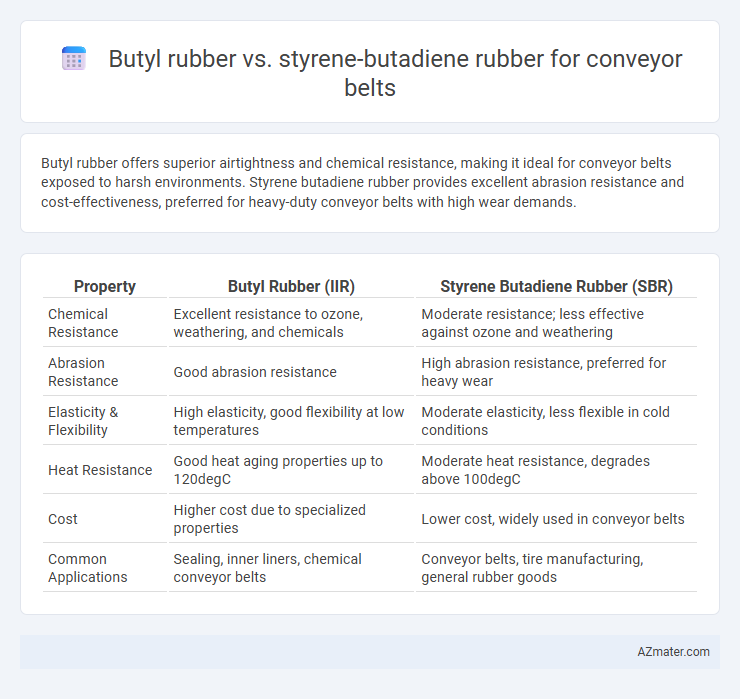Butyl rubber offers superior airtightness and chemical resistance, making it ideal for conveyor belts exposed to harsh environments. Styrene butadiene rubber provides excellent abrasion resistance and cost-effectiveness, preferred for heavy-duty conveyor belts with high wear demands.
Table of Comparison
| Property | Butyl Rubber (IIR) | Styrene Butadiene Rubber (SBR) |
|---|---|---|
| Chemical Resistance | Excellent resistance to ozone, weathering, and chemicals | Moderate resistance; less effective against ozone and weathering |
| Abrasion Resistance | Good abrasion resistance | High abrasion resistance, preferred for heavy wear |
| Elasticity & Flexibility | High elasticity, good flexibility at low temperatures | Moderate elasticity, less flexible in cold conditions |
| Heat Resistance | Good heat aging properties up to 120degC | Moderate heat resistance, degrades above 100degC |
| Cost | Higher cost due to specialized properties | Lower cost, widely used in conveyor belts |
| Common Applications | Sealing, inner liners, chemical conveyor belts | Conveyor belts, tire manufacturing, general rubber goods |
Introduction to Conveyor Belt Materials
Butyl rubber offers excellent impermeability and resistance to chemicals, making it suitable for conveyor belts exposed to harsh environments and aggressive substances. Styrene butadiene rubber (SBR) provides superior abrasion resistance and tensile strength, ensuring durability for heavy-duty conveyor belt applications. Selecting the appropriate material depends on specific operational conditions such as temperature, chemical exposure, and mechanical stress.
Overview of Butyl Rubber
Butyl rubber is a synthetic rubber known for its excellent impermeability to gases and outstanding resistance to heat, ozone, and weathering, making it suitable for conveyor belts exposed to harsh environments. Compared to styrene butadiene rubber (SBR), butyl rubber offers superior elasticity and durability, enhancing the conveyor belt's lifespan under continuous stress. Its chemical stability and low gas permeability make it an ideal choice for conveyor belts transporting sensitive or volatile materials.
Overview of Styrene Butadiene Rubber (SBR)
Styrene Butadiene Rubber (SBR) is a synthetic elastomer widely used in conveyor belts due to its excellent abrasion resistance and durability under harsh conditions. Compared to Butyl rubber, SBR offers superior tensile strength and resilience, making it ideal for heavy-duty conveyor applications. Its cost-effectiveness and versatility in temperature endurance add to its preference in industrial settings.
Key Performance Differences: Butyl vs SBR
Butyl rubber exhibits exceptional airtightness and chemical resistance, making it ideal for conveyor belts exposed to harsh chemicals and abrasive materials. Styrene butadiene rubber (SBR) offers superior abrasion resistance and high tensile strength, providing durability under heavy mechanical stress. However, SBR tends to have lower resistance to ozone and weathering compared to butyl rubber, impacting its longevity in outdoor conveyor applications.
Durability and Wear Resistance Comparison
Butyl rubber exhibits superior chemical resistance and elasticity, making it highly durable against abrasion and harsh environmental conditions in conveyor belts. Styrene butadiene rubber (SBR), while offering excellent wear resistance due to its high tensile strength and tear resistance, tends to degrade faster under UV exposure and ozone. For conveyor belt applications requiring extended lifespan and resilience to diverse chemicals and extreme temperatures, butyl rubber outperforms SBR in durability and wear resistance.
Chemical and Temperature Resistance
Butyl rubber exhibits superior chemical resistance to acids, bases, and ozone, making it ideal for conveyor belts exposed to harsh chemicals and aggressive environments. Styrene butadiene rubber (SBR) offers better abrasion resistance but is less resistant to heat and chemicals, limiting its performance in high-temperature or corrosive settings. Temperature resistance of butyl rubber ranges from -40degC to 120degC, while SBR typically withstands -40degC to 100degC, influencing material choice based on operational conditions.
Cost Analysis: Butyl Rubber vs SBR
Butyl rubber typically incurs higher initial costs compared to Styrene Butadiene Rubber (SBR) due to its superior chemical resistance and impermeability, which may justify the price for specialized conveyor belt applications requiring enhanced durability. SBR, being more affordable and widely available, offers cost-effective performance for general conveyor belt uses but may require more frequent replacement or maintenance under harsh conditions. Evaluating lifecycle costs including maintenance, longevity, and operational downtimes is crucial in determining the overall cost-efficiency between butyl rubber and SBR conveyor belts.
Applications in Conveyor Belt Manufacturing
Butyl rubber exhibits superior airtightness and chemical resistance, making it ideal for conveyor belts used in environments with exposure to oils, solvents, and harsh chemicals. Styrene butadiene rubber (SBR) offers excellent abrasion resistance and cost-effectiveness, suitable for general-purpose conveyor belts in mining, quarrying, and bulk material handling. Manufacturers often choose butyl rubber for conveyor belts requiring high durability and resistance to aging, while SBR is preferred for belts demanding toughness and good wear performance under heavy load conditions.
Environmental and Safety Considerations
Butyl rubber offers superior chemical resistance and low permeability to gases, making it ideal for conveyor belts in harsh environments where exposure to oils and chemicals is common. Styrene butadiene rubber (SBR) provides excellent abrasion resistance and durability but may release more volatile organic compounds (VOCs) during manufacturing and use, raising environmental concerns. Both materials require compliance with industrial safety standards, but butyl rubber's lower toxicity profile and better aging resistance contribute to a safer and more eco-friendly conveyor belt solution.
Selecting the Right Material for Conveyor Belts
Selecting the right material for conveyor belts involves comparing Butyl rubber and Styrene Butadiene Rubber (SBR) based on their durability and chemical resistance. Butyl rubber offers superior ozone and weather resistance, making it ideal for outdoor conveyor belts exposed to harsh environmental conditions. SBR provides excellent abrasion resistance and cost-effectiveness, suitable for heavy-duty conveyor belts handling rough materials in industrial settings.

Infographic: Butyl rubber vs Styrene butadiene rubber for Conveyor belt
 azmater.com
azmater.com